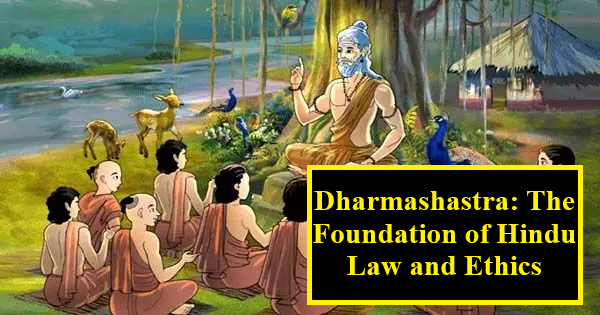
An in-depth look at Dharmashastra — the ancient Hindu code that governed law, ethics, and everyday conduct for centuries.
Dharmashastra: The Foundation of Hindu Law and Ethics
Introduction: Understanding Dharmashastra
Dharmashastra refers to a genre of Sanskrit texts that serve as the legal and ethical framework within Hindu tradition. These texts provide guidelines on righteous living, social duties, and moral conduct, aiming to establish a just and harmonious society. While rooted in ancient Indian society, the principles outlined in Dharmashastras continue to influence contemporary discussions on law and ethics.
I. Historical Context and Evolution
1. Emergence of Dharmashastra
The origins of Dharmashastra can be traced back to the Dharmasutras, concise prose texts composed between 600 BCE and 200 CE. These early works laid the groundwork for the more elaborate Dharmashastras, which were composed in poetic verses and expanded upon the principles of dharma.
2. Prominent Dharmashastra Texts
Manusmriti: Attributed to Sage Manu, this is perhaps the most well-known Dharmashastra, detailing laws on social conduct, caste duties, and justice.
Yājñavalkya Smṛti: A more systematic and humane text, it delves into judicial processes and is considered a significant contribution to Hindu jurisprudence.
Gautama Dharmasutra: Emphasizes the duties of kings and the administration of justice, highlighting the role of the state in upholding dharma.
Vashishta Dharmasutra: Focuses on personal conduct, rituals, and the duties of individuals in various stages of life.
II. Core Principles of Dharmashastra
1. Dharma
At the heart of Dharmashastra is the concept of dharma, encompassing righteousness, duty, law, morality, and justice. It serves as the foundation for a just and harmonious society, guiding individuals in their roles and responsibilities.
2. Varna and Ashrama
Varna: The social classification into four main categories—Brahmins (priests), Kshatriyas (warriors), Vaishyas (merchants), and Shudras (laborers)—each with prescribed duties and responsibilities.
Ashrama: The four stages of life—Brahmacharya (student), Grihastha (householder), Vanaprastha (retired), and Sannyasa (renunciant)—each stage having its own set of duties and expectations.
3. Karma and Reincarnation
Dharmashastras emphasize the law of karma, where every action has consequences, influencing one's future lives through the cycle of samsara (reincarnation). Adherence to dharma leads to positive karma, while deviations result in negative karma.
4. Justice and Legal Procedures
The texts outline procedures for administering justice, including rules for courts, evidence, witnesses, and punishments. They emphasize the importance of fairness and impartiality in legal matters.
III. Structure of Dharmashastra Texts
Dharmashastra texts are typically divided into three main sections:
Achara: Deals with daily rituals, life-cycle rites, and specific duties and proper conduct for each varna and ashrama.
Vyavahara: Concerns laws and legal procedures, including the duties of the king, judicial processes, and dispute resolution.
Prayaschitta: Outlines rules for penances and expiations for violating the laws of dharma.
IV. Influence and Legacy
1. Social Structure
Dharmashastras played a pivotal role in shaping the social structure of ancient India, reinforcing the varna system and prescribing duties for each class.
2. Legal System
The principles outlined in Dharmashastras influenced the development of Hindu law and the administration of justice, laying the foundation for legal practices in ancient India.
3. Modern Relevance
While many aspects of Dharmashastras have been critiqued and reformed, their emphasis on ethics, justice, and social responsibility continues to be relevant in contemporary discussions on law and morality.
V. Critiques and Controversies
Dharmashastras have faced criticism for their rigid social hierarchies and gender biases. Notably, Dr. B.R. Ambedkar denounced the Manusmriti for its discriminatory provisions and publicly burned a copy in 1927 as a protest against caste-based oppression.
VI. Conclusion
Dharmashastra represents a significant aspect of Hindu tradition, offering insights into ancient Indian society's legal and ethical frameworks. While certain aspects require critical examination, the core principles of justice, duty, and morality continue to resonate in modern times.
MCQs on Dharmashastra
Which of the following is a central concept in Dharmashastra?
a) Moksha
b) Dharma
c) Artha
d) Karma
Answer: b) Dharma
The Dharmashastra texts are primarily composed in which form?
a) Prose
b) Poetry
c) Dialogue
d) Hymns
Answer: b) Poetry
Which Dharmashastra is attributed to Sage Manu?
a) Yājñavalkya Smṛti
b) Gautama Dharmasutra
c) Manusmriti
d) Vashishta Dharmasutra
Answer: c) Manusmriti
The concept of 'karma' in Dharmashastra refers to:
a) Ritual sacrifices
b) Actions and their consequences
c) Social duties
d) Spiritual liberation
Answer: b) Actions and their consequences
Which section of Dharmashastra deals with daily rituals and life-cycle rites?
a) Vyavahara
b) Prayaschitta
c) Achara
d) Karma
Answer: c) Achara
UPSC-Level Analytical Questions
Analyze the role of Dharmashastra in shaping the social and legal structures of ancient India. Discuss its relevance in contemporary Indian society. (250 words)
Critically evaluate the criticisms of Dharmashastra, particularly Manusmriti, concerning social hierarchies and gender biases. How have these critiques influenced modern legal reforms in India? (250 words)
11-Jul-2025 02:29 PM
Explore the fascinating structure, origin, and dynamics of our Earth—from...
11-Jul-2025 02:18 PM
Understand the vital role of lysosomes and cellular transmission in...
11-Jul-2025 01:48 PM
A concise and exam-focused overview of Plasmolysis and Protoplasm, covering...
04-Jul-2025 12:46 PM
India’s education system is undergoing a major transformation to prepare...
02-Jul-2025 02:51 PM
Recent research suggests that the transfer of genes between fungi...
12-Jun-2025 10:56 AM
Unravel the legend and legacy of Manu — the progenitor...
12-Jun-2025 04:51 PM
A deep dive into Daṇḍaśāstra, the traditional Indian science of...
12-Jun-2025 05:01 PM
A comprehensive look at the four Purusharthas—Dharma, Artha, Kama, and...
12-Jun-2025 05:15 PM
An insightful exploration of the Varnashrama system—its origins, principles, and...
Leave a Comment